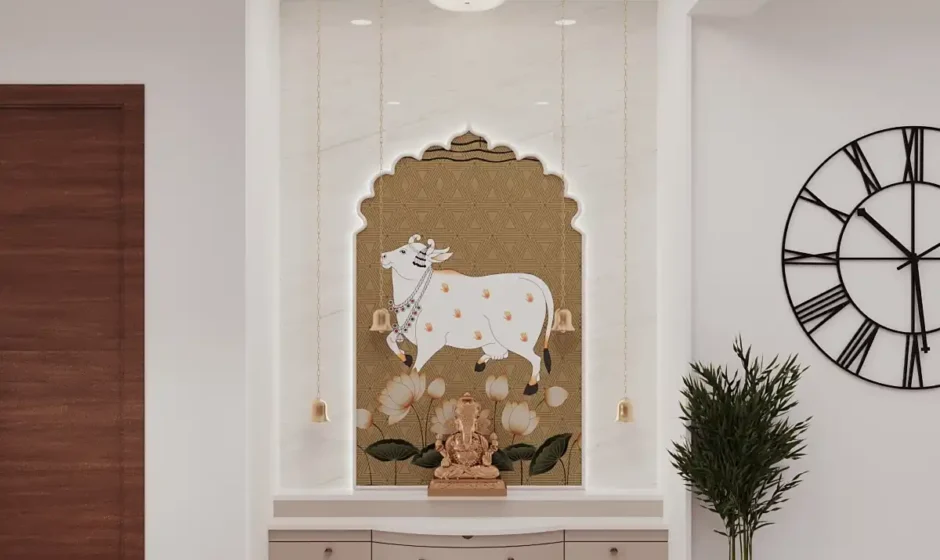Introduction: The Essence of a Pooja Room Design
A pooja room, also known as a prayer room, is one of the most sacred spaces in an Indian home. It is where families come together to perform rituals, offer prayers, and find solace. Traditionally, pooja rooms have been designed with specific elements such as wooden temples, intricate carvings, brass idols, and a focus on vastu principles. However, in today’s modern homes, especially in apartments or small spaces, there’s a growing interest in blending traditional pooja room designs with contemporary aesthetics. By fusing traditional and modern design elements, you can create a pooja room that not only reflects your cultural heritage but also fits seamlessly into the style of your home.
In this article, we will explore practical ways to combine these design styles while ensuring that the pooja room remains sacred, functional, and aligned with modern-day convenience.
Understanding the Balance Between Traditional and Modern Pooja Room Designs
A key question when designing a pooja room is how to respect traditional customs while embracing modern trends. The answer lies in understanding both styles and knowing which elements can be combined.
Traditional Design Elements for Pooja Rooms:
- Wooden Altars and Temples: Traditional pooja rooms often feature wooden temples made from teak, rosewood, or other solid wood. The altar is the focal point of the room and is intricately carved with religious motifs.
- Brass and Stone Idols: Idols made from brass, copper, or stone are commonly used in traditional pooja room designs. These materials have spiritual significance and are part of the traditional pooja setup.
- Vastu Elements: Traditional pooja rooms are designed according to vastu principles, such as placing the pooja room in the northeast corner, ensuring that the deities face the west, and keeping the area clean and clutter-free.
- Intricate Detailing: Decorative elements like carvings, brass lamps, bells, and a mix of cultural motifs are key components of traditional pooja rooms.
Modern Design Elements for Pooja Rooms:
- Minimalist Design: Modern pooja rooms focus on minimalism, where less is more. Clean lines, neutral color palettes, and minimal furnishings define the space.
- Sleek Furniture: Furniture in modern pooja rooms can include sleek cabinets or consoles for storing religious items. Instead of traditional wooden temples, some opt for contemporary designs that maintain functionality while having a modern look.
- Smart Lighting: Modern lighting fixtures, such as LED strips or smart lighting systems, allow for mood-setting and ease of use, perfect for the modern pooja room.
- Glass, Metal, and Acrylic Materials: Many modern pooja rooms use materials like glass, metal, and acrylic for their clean, contemporary look, often incorporated in furniture, lighting, and temple design.
Blending Traditional and Modern Design in Your Pooja Room
Combining traditional and modern design elements in a pooja room is not only possible but also a great way to create a unique space that meets both functional and aesthetic needs. Below are practical tips for incorporating both styles into your pooja room designs.
1. Combine Materials Thoughtfully
One of the most effective ways to merge traditional and modern design is by blending materials. Traditional wooden temples or altars can be paired with modern, sleek storage solutions or minimalist wall-mounted shelves. For example:
- Wood and Glass: Combine a traditional wooden altar with a glass wall partition or glass shelves to display idols and other sacred items.
- Metal and Stone: Pair metal lanterns or LED lighting with traditional stone idols, bringing a modern touch to a timeless tradition.
2. Use Modern Furniture with Traditional Touches
While traditional wooden furniture may dominate pooja rooms, you can still bring in contemporary elements without losing the spiritual essence.
- Modern Storage Solutions: Instead of traditional cabinets, use minimalist, modern storage units that can house your religious items. These could be in materials like lacquered wood or metal, with clean, simple lines.
- Modern Seating: Replace traditional floor seating with minimalist benches or cushions that offer comfort but maintain a contemporary aesthetic.
3. Smart Lighting with Traditional Aesthetic
Lighting plays a pivotal role in both traditional and modern pooja room designs.
- Brass or Copper Lamps: Use traditional brass or copper lamps as part of the decor, but complement them with modern LED recessed lighting or accent lighting that highlights the altar.
- Mood Lighting: Modern mood lighting can set the tone for your pooja room, enhancing the spiritual experience with soft, ambient light that still feels traditional.
4. Vastu Compliant with Modern Elements
If you’re designing your pooja room according to vastu principles, you can still embrace a modern aesthetic. For example:
- Vastu-Friendly Layout: Place your pooja room in the northeast direction, as per vastu, but incorporate modern design principles such as open shelving or minimalist furniture that respects vastu guidelines.
- Clean and Clutter-Free: Even in modern designs, ensure the pooja room remains clutter-free. Choose storage solutions that hide away items but maintain a sleek, clean appearance.
5. Focusing on Colors and Textures
Colors and textures can dramatically affect the vibe of a pooja room. While traditional pooja rooms often feature earthy tones like browns, golds, and reds, you can modernize the palette with muted tones such as whites, grays, or pastels.
- Wall Treatments: Instead of traditional wall paintings, modern pooja rooms may incorporate textured or stone finishes. Subtle, modern wallpaper designs with spiritual motifs can also be a good compromise between traditional and contemporary.
- Accent Colors: Add traditional colors like deep reds, oranges, or gold as accent colors to complement the minimalist design.
How Interior Designers Near Me Can Help Create the Perfect Pooja Room
If you’re unsure about how to combine traditional and modern design elements in your pooja room, working with interior designers near me can help bring your vision to life. Here’s how they can assist:
- Expert Advice on Materials and Layout: Interior designers can suggest materials that align with both modern aesthetics and traditional values. They will guide you on how to position furniture, idols, and lighting for maximum spiritual and aesthetic impact.
- Customized Designs: Experienced interior designers can provide tailored solutions based on your space, budget, and style preferences. Whether you want a more traditional or modern design, they can create a balanced look.
- Incorporating Vastu Principles: Interior designers well-versed in vastu can design a pooja room that meets your spiritual needs while incorporating modern elements seamlessly.
- Functional and Beautiful Design: Interior designers ensure that your pooja room is both functional and aesthetically pleasing, making it a space where you can perform your rituals comfortably while enjoying a modern aesthetic.
Conclusion
Combining traditional and modern design elements in your pooja room is an excellent way to create a space that is both spiritually fulfilling and aligned with contemporary design trends. By blending traditional materials, such as wood and brass, with modern elements like sleek furniture and smart lighting, you can design a pooja room that feels timeless yet modern. If you’re considering this blend of styles, consult with experienced interior designers near me who can help you create a pooja room that respects your cultural heritage while reflecting your unique design preferences. With the right balance, your pooja room can become a beautiful, peaceful retreat that serves as the heart of your home.



